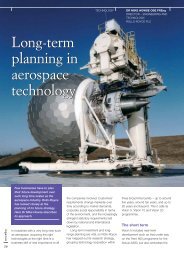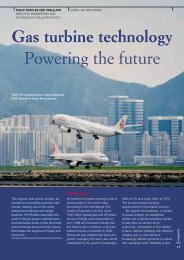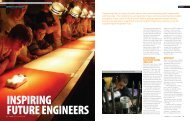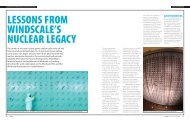You also want an ePaper? Increase the reach of your titles
YUMPU automatically turns print PDFs into web optimized ePapers that Google loves.
INNOVATION<br />
A high pressure test rig constructed for flow loop testing © Brinker Technology<br />
SEALING SOLUTIONS<br />
A tiny cut on a finger inspired a leak-sealing innovation which has the potential to change<br />
the shape of integrity management across the pipeline industry worldwide. Klaire Evans<br />
from Brinker Technology, a MacRobert Award 2006 finalist, talks about the company’s<br />
journey from concept to field implementation.<br />
INGENIA ISSUE 29 DECEMBER 2006 41
SEALING SOLUTIONS<br />
INNOVATION FEATURE<br />
Fluid leaks from a<br />
defect in the pipeline<br />
42 INGENIA ISSUE 29 DECEMBER 2006<br />
Platelets® introduced<br />
into line and carried to<br />
the leak site with fluid<br />
flow<br />
In 1998, Ian McEwan, a Reader from the<br />
University of Aberdeen, was travelling on<br />
a train reading an article about leakage<br />
problems in the UK water industry, and cut<br />
his finger on the paper. This cut, and its<br />
subsequent healing, led Ian to question<br />
whether the method the human body uses<br />
to seal cuts and wounds could be adapted<br />
for use in pressurised pipelines. Here, the<br />
concept of Platelet Technology was born.<br />
Platelets in the human body are<br />
irregularly-shaped, discrete particles which<br />
constantly patrol our veins. When bleeding<br />
from a wound occurs the platelets react,<br />
gathering at the leak site and attempting to<br />
stem the blood flow. Ian sought to take this<br />
concept and adapt it for use in industrial<br />
pipelines using his research field of particle<br />
and flow mechanics. He surmised that<br />
discrete specially-designed particles could<br />
be injected into a pipeline at a position<br />
upstream of a known or suspected defect.<br />
The particles would then utilise the fluid flow<br />
inside the pipeline to travel to the leak site.<br />
GOING WITH THE FLOW<br />
Designing these particles with the necessary<br />
material properties would enable fluid forces<br />
to draw them into the leak and hold them<br />
against the pipe wall, thus facilitating sealing.<br />
By embedding a remote tagging device into<br />
these discrete particles prior to deployment<br />
they can also be used to locate leaks. Once<br />
the particle is entrained into the defect the<br />
embedded tag is uniquely positioned at<br />
the leak site and can be detected by running<br />
a suitable device either externally or<br />
internally along the length of the pipeline.<br />
Platelet Technology enables leaks to be<br />
sealed and located in a single integrated<br />
process. This reduces the lifetime of the leak,<br />
which helps to limit any consequential<br />
environmental damage. Platelets® are<br />
A number of Platelets®<br />
become entrained into<br />
the leak<br />
implemented remotely, removing the need<br />
for direct access to the leak site which helps<br />
to ensure the safety of those involved in<br />
the repair. In addition, Platelets require no<br />
disturbance to pipeline operation meaning<br />
that, in some cases, costly shutdowns can<br />
be avoided.<br />
A BESPOKE SYSTEM<br />
The material that a batch of Platelets is<br />
made from is dictated by the environment<br />
in which it must operate. For example, fluid<br />
compatibility is a strong consideration when<br />
selecting the optimum material for a specific<br />
operation. A material must be selected<br />
which is not adversely affected by the carrier<br />
fluid for the required duration of the Platelet<br />
seal, which in some organic, high<br />
pressure/high temperature applications<br />
can prove very challenging.<br />
The operating pressure of the line also<br />
has a strong bearing on the selection of<br />
Platelet material – if the material is too soft<br />
it may be entirely extruded through the leak,<br />
but if the material is too hard a complete<br />
seal may not be attainable. For this reason<br />
a wide variety of materials have been used<br />
on Platelet operations to date, for which the<br />
pressures have varied from 2 to over 500 bar.<br />
MADE TO MEASURE<br />
The exact size and shape of a Platelet cannot<br />
be defined because it varies from operation<br />
to operation. For each operation undertaken<br />
by Brinker Technology, unique batches of<br />
Platelets are manufactured with properties<br />
which are specifically tuned to give the<br />
optimum results under the operating<br />
conditions in question. To give some idea,<br />
in projects carried out to date, defect sizes<br />
ranging from 0.3mm to 50mm diameter<br />
have been successfully sealed.<br />
Seal achieved – excess<br />
Platelets® continue<br />
down the line<br />
Platelets®<br />
Detection process can<br />
be carried out<br />
Platelets utilise the turbulent flow in pipelines<br />
to become evenly distributed across the<br />
pipeline cross-section, enabling leaks at any<br />
location to be targeted. To do this they need<br />
to be neutrally buoyant in the carrier fluid (ie<br />
the same density) and therefore this too affects<br />
the choice of material for each application.<br />
As such, there is no hard and fast rule which<br />
governs what a Platelet is made from; however,<br />
polymeric and elastomeric materials have<br />
demonstrated a good combination of<br />
properties for most applications.<br />
BACKGROUND PREPARATIONS<br />
Although the concept is elegant in its<br />
simplicity, underpinning the theory is<br />
extensive use of Computational Fluid<br />
Dynamics (CFD) in conjunction with Finite<br />
Element Analysis, plus over five years of<br />
rigorous physical testing. In non-urgent uses,<br />
when presented with a new application the<br />
first stage in the engineering process is to<br />
The use of both physical and numerical tools is crucial to<br />
the success of the entire approach because it gives much<br />
confidence in the quality and robustness of the solution.<br />
Particle traces coloured by velocity magnitude (m/s)<br />
Particle traces coloured by particle residence time (s)<br />
Figures 2 and 3. Computational Fluid Dynamics is used to assess Platelet entrainment rates © Brinker Technology<br />
INGENIA ISSUE 29 DECEMBER 2006 43
SEALING SOLUTIONS FEATURE<br />
INNOVATION FEATURE<br />
Since this first operation in 2004 Platelet Technology<br />
has repeatedly been used on live operations, most notably<br />
in August 2005 in a rapid response application for<br />
Shell. Brinker Technology were able to deliver a solution<br />
within five days from initial client contact.<br />
create a model of the defective pipeline<br />
geometry using CFD which enables all<br />
conditions in the line, such as pressure,<br />
flow rate, and fluid density and viscosity to<br />
be accurately simulated. Discrete particles,<br />
which represent Platelets, are then<br />
introduced into the pipeline and their<br />
behaviour around the leak monitored.<br />
This modelling process generates<br />
important information regarding Platelet<br />
dispersion and entrainment rates (see figures<br />
2 and 3) which enables the required batch<br />
sizes and Platelet densities to be calculated.<br />
Finite Element Analysis is then used to assess<br />
the structural integrity of entrained Platelets<br />
in position over a leak. This enables the effect<br />
of stresses and strains which the Platelet will<br />
experience in the field to be monitored and<br />
is a key tool when selecting the optimal<br />
material for Platelet manufacture.<br />
Using the information obtained from<br />
these numerical modelling processes,<br />
batches of Platelets are manufactured and<br />
subjected to rigorous physical testing. This<br />
involves flow loop testing to assess Platelet<br />
entrainment and pressure vessel testing to<br />
verify the Platelets’ structural integrity at<br />
representative pressure. If the results of<br />
the physical tests support those obtained<br />
analytically and numerically then there<br />
can be a high level of confidence and<br />
the solution is considered ready for<br />
implementation. The use of both physical<br />
44 INGENIA ISSUE 29 DECEMBER 2006<br />
and numerical tools is crucial to the<br />
success of the entire approach because<br />
it gives much confidence in the quality<br />
and robustness of the solution.<br />
INITIAL IMPLEMENTATION<br />
The first field use of Platelet Technology<br />
came as a result of a Joint Industry Project<br />
(JIP) funded by a number of North Sea oil<br />
majors. In September 2004, Platelets were<br />
successfully used to seal a water injection<br />
line leak in BP’s Foinaven field. The water<br />
injection method used in oil production<br />
is where water is injected back into the<br />
reservoir in order to increase the well<br />
pressure and thereby stimulate production.<br />
By supporting reservoir pressure in this way<br />
the product recovery from the well is<br />
increased as the oil is displaced by water<br />
and pushed to the top. In this instance, the<br />
pipeline geometry immediately upstream<br />
of the leak was relatively complex, with two<br />
90º bends immediately prior to the defect.<br />
This meant that flow in the near vicinity<br />
of the leak was non-uniform and directed<br />
away from the leak.<br />
CFD played a vital role in quantifying<br />
this effect and was used extensively in the<br />
development of a solution. A number of<br />
simulations were run with Platelets of a range<br />
of sizes and densities. It was found that by<br />
using Platelets of a lower density than the<br />
Figure 4. Simulated distribution of ‘neutrally buoyant’<br />
Platelets® across the pipeline (Platelet density = 1030<br />
kg/m3, sea-water density 1030 kg/m3) © Brinker<br />
Technology<br />
Figure 5. Simulated distribution of ‘light’ Platelets®<br />
across the pipeline (Platelet density = 1005 kg/m3,<br />
sea-water density 1026 kg/m3) © Brinker Technology<br />
carrier fluid (seawater, 1,030kg/m3) it was<br />
possible to increase entrainment rates,<br />
enabling the required batch size to be<br />
reduced. Figures 4 and 5 demonstrate the<br />
significant effects that a slight change in<br />
Platelet density has on their cross-sectional<br />
distribution in the pipe at the leak site.<br />
Here, the Platelet deployment was a<br />
complete success, with the leak sealed within<br />
24 hours of the start of the offshore<br />
operation. The Platelet seal enabled the line<br />
pressure to increase by 20 bar which resulted<br />
in a significant increase in production.<br />
Since this first operation in 2004 Platelet<br />
Technology has repeatedly been used on live<br />
operations, most notably in August 2005 in a<br />
rapid response application for Shell. Brinker<br />
Technology were able to deliver a solution<br />
within five days from initial client contact.<br />
Further low pressure ‘proof of concept’ trials<br />
were very promising and representative trials<br />
at 60 bar are scheduled to take place before<br />
the end of the year.<br />
LOW PRESSURE TRIALS<br />
In addition to this ongoing work in the oil<br />
and gas sector, Brinker Technology has<br />
been seeking to develop the technology for<br />
use in the water industry – a prime candidate<br />
for a novel leak sealing solution. In England<br />
and Wales alone 3,600 mega litres of water<br />
are lost every day due to leakage. This loss<br />
of valuable resources, combined with two<br />
unseasonably dry winters and rapid<br />
population growth has resulted in the<br />
south-east of England facing one of the<br />
most serious droughts of the last 100 years.<br />
Platelet Technology was recently trialled<br />
on a 4” disused clean water main, at a<br />
pressure of 4.5 bar. Although this pressure<br />
is significantly less than any encountered<br />
in the oil and gas industry, by selecting a<br />
material with the required characteristics<br />
(ie deformability under low force), successful<br />
seals were obtained on a variety of leak<br />
geometries.<br />
A number of barriers must be overcome<br />
before the technology can be used in this<br />
field. These include ensuring that the<br />
material used for Platelet manufacture has<br />
regulatory approval from the UK Drinking<br />
Water Inspectorate, and ensuring that<br />
procedures are in place to guarantee that<br />
Platelets cannot reach customer homes.<br />
Due to the fact that they do not have the<br />
same regulatory restrictions enforced<br />
upon them, raw untreated water or<br />
sewerage systems could be the first place<br />
that Platelets are deployed.<br />
A NON-INVASIVE TECHNOLOGY<br />
Despite the challenges that lie ahead<br />
Platelets have the potential to transform<br />
the way the water industry deals with leaks.<br />
Platelets are implemented remotely and<br />
travel to the leak site with the flow in the<br />
line, so they are a ideal example of a ‘no-dig’<br />
technology. This means that disruptions<br />
to traffic currently caused by technologies<br />
which require direct access to buried<br />
pipelines could be avoided.<br />
It has been estimated by industry experts<br />
that reducing the leakage across England<br />
and Wales by 10% (360 Ml/d) through<br />
traditional dig and repair methods will cost<br />
around £2.5 billion in capital expense.<br />
Platelet Technology has the potential to<br />
significantly reduce this figure to the benefit<br />
of the 52 million customers nationwide.<br />
It has been estimated by industry experts that reducing<br />
the leakage across England and Wales by 10% (360 Ml/d)<br />
through traditional dig and repair methods will cost around<br />
£2.5 billion in capital expense.<br />
Further reference<br />
www.brinker-technology.com<br />
BIOGRAPHY – Klaire Evans MEng AMIMechE<br />
Klaire read Mechanical Engineering at Exeter University and graduated with a First Class<br />
Honours Degree in 2002. She began her career with ExxonMobil on their Graduate<br />
Development Programme, run in conjunction with the London Business School. Klaire<br />
joined Brinker Technology in March 2005 as a Projects Engineer and a year later moved<br />
to the position of Sales and Marketing Engineer.<br />
INGENIA ISSUE 29 DECEMBER 2006 45





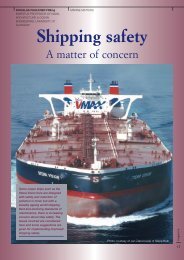



![[322/03] Francke - Ingenia](https://img.yumpu.com/23411337/1/184x260/322-03-francke-ingenia.jpg?quality=85)

